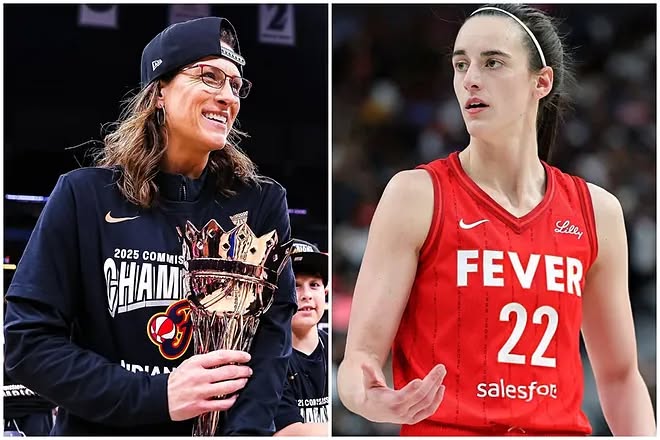RAW TRUTH: Fever Coach Stephanie White Opens Up on Challenges of Playing Without Caitlin Clark
Stephanie White, head coach of the Indiana Fever, has faced the season’s toughest stretch yet: navigating life without the franchise’s centerpiece, Caitlin Clark. With Clark sidelined multiple times by nagging leg injuries, White has stepped into the spotlight, offering blunt, clear-eyed insight into the team’s struggles, adjustments, and the raw truth of competing without its marquee star.
When Clark suffered a left quadriceps strain on May 26, 2025, it marked her second major injury of the season. At that point, she’d been averaging 19 points, 9.3 assists, and contributed heavily to the Fever’s offensive engine . Clark’s absence sent ripples through the roster, demanding a new identity. White, pragmatic and unflinching, faced the daunting task of redefining the team’s framework midstream.
From the outset, White highlighted how much of the Fever’s rhythm hinged on Clark’s ball handling and spacing. “We’ve got to learn to make big plays in tough moments on both ends… learning to play without [Caitlin] is important because that’s gonna pay dividends down the stretch” . This candid recognition underscores the core issue: losing Clark doesn’t just subtract points—it removes the system’s central pivot.
White’s approach has been methodical. She advocated for ramping up physicality in practice, urging the team to “get beat the hell out of us” in simulated scrimmages against the (male) practice squad, building resilience for real-game roughne. That toughness—or lack thereof—revealed itself sharply in a lopsided loss to the Atlanta Dream. Indiana was dominated in the paint, losing the rebounding battle 44–27, while being outscored 46–28 inside . White didn’t sugarcoat the failure: “They took advantage” of Indiana’s lack of post physicality .
That same evening, White issued a message to the coaching staff as much as the players: losing double-digit leads wasn’t just about effort—it pointed to strategic lapses. She said, “We have to be better as coaches at preparing them for that…and we have to be better executing it” .
In postgame sessions, White has refused to point fingers at personnel. After a tough loss to the Washington Mystics, triggered by lineup changes due to Clark’s and other teammates’ leg troubles, she dissected their offensive stagnation. She observed a pattern: under pressure, the Fever “settle for one-on-one, jump shots, dribble hand-offs,” instead of moving the ball through off-ball schemes Such lapses are understandable—without Clark to orchestrate transitions, the team reverts to comfort plays and “old habits.” The result is unbalanced offense and defensive lapse, especially when missing their leader initiates performance anxiety.
Critics have seized these moments. Some fans and analysts have questioned White’s decision-making, particularly in personnel deployment. One hot topic: the extension of veteran Sydney Colson’s minutes over more dynamic alternatives like Sophie Cunningham—a decision that drew sharp criticism after a brutal outing against Washington . Others have turned to social media to denounce White’s cautious tempo, demanding a return to full-speed ball movement to maximize Clark’s strengths: “White needs to watch Fever games from last season and see how fast‑paced is the only way they will beat teams”
White, however, remains unwavering. She’s focused on building depth, making the offense less predictable, and allowing Clark to rest without derailing the team. Listen to her on the “Good Follow Podcast”: “Think of using her (Clark) off-ball, third‑and‑fourth side… how we use her to help everybody else be better off the ball… we are not going to take that away”
Still, the Fever’s inconsistency is glaring. Their record hovers around .500 when Clark is out—currently 4–5 and holding steady at 8–8 overall . Offensive shooting dips deep: 36% overall, 21% from three, with defensive rotations lacking punch . Each game without Clark feels like an inflation test—can players like Aliyah Boston, Kelsey Mitchell, DeWanna Bonner, and Natasha Howard step up to fill the vacuum?
White’s response: yes. In a shining example, the Fever claimed the Commissioner’s Cup semifinal against the Minnesota Lynx, 74‑59, even without Clark . Howard had a double‑double and the squad rallied defensively in the second half. White pointed out the long‑term payoff: “Playing without [Clark]… making big plays in tough moments… that’s gonna pay dividends down the stretch of the season” .
Yet nothing replaces Clark’s unique brand. She’s not just a scorer; she draws national attention. With over 1.29 million All‑Star votes, including becoming an All‑Star captain, Clark has become a cultural phenomenon . Economists such as those at Indiana University pegged the “Caitlin Clark effect” as adding $36 million to Indianapolis’s GDP—over 25% of the Fever’s revenue comes from her presence . The league’s broader growth, including investments in expansion teams, is tied to her star power .
That reality makes it a gamble when she sits. White’s challenge isn’t simply covering points and assists; it’s maintaining fan engagement and team confidence. She’s tasked with proving that the Fever can fight without their queen. As Clark nurses new groin tightness—her sixth miss—White and the organization must hold firm to a core message: this team stands tall regardless of availability .
Clark’s own mindset echoes the coach’s approach—observant, tempered by realism. She recognizes the slump, the physical toll, and the mental weight of expectations. But Clark also pointed out that she’s been targeted—”nobody feels sorry for you… we just have to figure it out”—and White has mirrored that toughness .
How White instills resilience matters. After Atlanta’s beatdown, she demanded more contact in practice. After Washington, she studied rotation breakdowns. After Cleveland, she articulated exactly what went wrong. She doesn’t deflect scrutiny but uses it to teach.
Critics will highlight lost lead blowouts, turnover surges, and strategic backfires. Yet White isn’t shrinking. Instead, she’s using each stumble to build a blueprint for success—one not anchored solely to Clark, but to a collective identity.
Realists understand that returning Clark raises hopes, but also renews challenges: how to balance her usage, manage her minutes, and integrate others. White’s vocal plan is to do just that: ease Clark into off‑ball roles, spread the load, and preserve key moments for her dominance . This ensures that when Clark’s on the floor, she’s explosive—not exhausted.
Still, the risk is real. The Fever’s depth has been tested already with injuries to Colson and Cunningham . Aari McDonald was signed and waived. Roster stress is high. Against this backdrop, White’s public recognition of shortcomings—on physicality, spacing, rotation—signals accountability. It also sends a message: she’s not hiding behind Clark’s narrative, but owning her version of the story.
As the first half of the season closes, two metrics will define White’s job: resilience without Clark—and cohesion with her. Can this squad win meaningful games in her absence? And will the team mesh seamlessly when Clark returns?
The Commissioner’s Cup win offers a glimpse. But it also raised questions: can that performance be a foundation instead of a flash? When Clark inevitably returns, can White shift the playing style quickly? Will the team maintain defensive stiffness and offensive creativity? Can the emotionally energized Fever adopt a “fast‑pace, up‑tempo” identity that maximizes ball movement and keeps opponents off balance
White wants to answer yes. As she told reporters on a brutal loss: “Nobody feels sorry for you… we just have to figure it out” . It’s raw, tough love. She knows that WNBA success demands grit both on and off the court.
So far, White’s raw honesty has been refreshing—even if it hasn’t led to a spotless record. Her leadership is defined by transparency. When the team fails, she takes ownership. When structural flaws emerge, she identifies them. And when victories come—Commissioner’s Cup—it’s elevated as groundwork for future triumphs.
Clark’s return will shift the energy. But as White has emphasized, the long‑term goal is to build a Fever that transcends star dependence. A team that can initiate runs, defend with intensity, rotate defense, rebound, and spread shots—even without its nucleus. Clark remains the driver, but White’s blueprint aims to make her only part, not all, of the journey.
The raw truth is clear: life without Caitlin Clark forces the Fever to confront their core identity. Stephanie White isn’t shying away from the challenge. She’s leaning into it, demanding more, diagnosing failures, and building a system that can sustain shocks. It’s a high‑risk, high-reward gambit—but one White believes in.
Because at the end of the day, a durable team is one that fights through adversity, builds depth, and honors its star without relying on her. If White succeeds, the Fever become real contenders. If not, the losses without Clark will define this season’s story.
But for now, the raw truth emerges from White’s voice—not sanitized PR—delivered with unfiltered honesty, accountability, and a battle‑ready voice asking her team to rise. That is the challenge she’s embraced.



